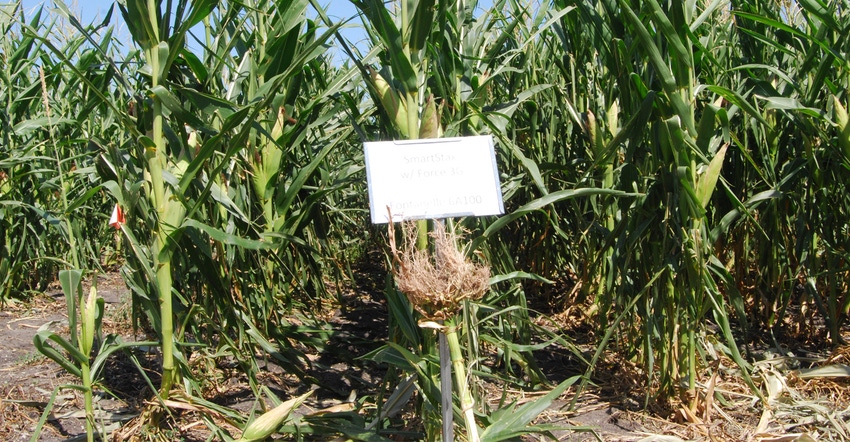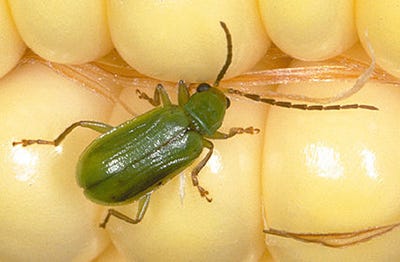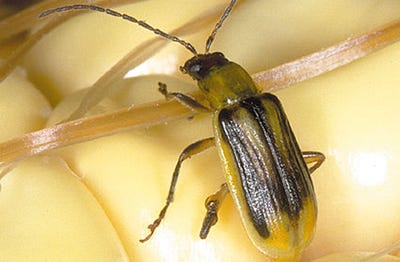December 12, 2019

A single control tactic for a crop pest is never the answer, whether trying to manage corn rootworm, or other insects, weeds or diseases. Repeated use of a single tactic speeds up resistance development.
There are many examples of this in recent years, including waterhemp resistance to certain herbicides, frogeye leaf spot resistance to Qoi (strobilurin) fungicides and corn rootworm resistance to Bt-corn rootworm hybrids.
Consider using multiple tactics over the long term to best control corn rootworm and to conserve the ability of those tactics to continue to provide control. There are three major tactics, plus a fourth less cost-effective option, to include in an integrated pest management (IPM) program for controlling corn rootworm:
1. Crop rotation. Rotating corn with a non-corn crop remains a very effective rootworm control tactic in Iowa. Spring-hatched rootworm larvae need to feed on corn roots for this pest to grow and develop. A field planted to non-host crops like soybeans, small grains or alfalfa eliminates the corn rootworm population at no added expense. The exception to rootworm control by a simple crop rotation (such as corn-soybean-corn-soybean) is in areas where there is more frequent occurrence of extended diapause.
 NORTHERNS: Pale green when newly emerged, the Northern species of corn rootworm beetles become greener with age.
NORTHERNS: Pale green when newly emerged, the Northern species of corn rootworm beetles become greener with age.

Extended diapause can occur in the Northern species of corn rootworm. It happens when eggs laid in soil by the northern corn rootworm adult beetles in the fall do not hatch the next year (the nonhost crop year), but instead hatch in two years when the field is planted again to corn. This is first-year corn, but it can be damaged if rootworms with the extended diapause characteristic are present in the field. Extended diapause is most evident in north-central and northwest Iowa. However, control of northern corn rootworm, including populations that have extended diapause, can still be achieved by using soil-applied insecticides or by planting Bt-corn rootworm hybrids.
2. Soil-applied insecticides. Applied to soil at planting, insecticides are still an effective method of control and should be included in a corn rootworm IPM program. In a corn-corn-corn-soybean or corn-corn-corn-hay rotation, an IPM program could use crop rotation as the sole control in first-year corn, then use soil-applied insecticide with a non-corn rootworm Bt hybrid for second-year corn, and then a Bt-corn rootworm hybrid for third-year corn.
3. Bt-corn hybrid management. Managing Bt corn to control rootworm is not getting any easier. ISU entomologists confirmed the first rootworm resistance to Bt corn occurred with western corn rootworm in 2009 cornfields in northeast Iowa. Since then, ISU has confirmed western corn rootworm resistance to all four Bt corn rootworm traits, along with a significant degree of cross-resistance in three of the four traits. Last year North Dakota State University confirmed Bt corn rootworm resistance to northern corn rootworm.
 WESTERNS: The Western species of corn rootworm adult beetles are yellow to green with black stripes on the forewings.
WESTERNS: The Western species of corn rootworm adult beetles are yellow to green with black stripes on the forewings.

While most of Iowa can still obtain successful control of corn rootworm with Bt-corn hybrids, it is recommended to use hybrids with pyramided traits. That is, use two of the four Bt corn rootworm traits. The most common recommendation is to use hybrids that contain the Cry34/35Ab1 trait plus a second trait of any of the three-remaining rootworm Bt-traits (Cry3Bb1, mCry3A, eCry3.1Ab). For cornfields that have had repeated problems with Bt-corn rootworm resistance, IPM requires more emphasis on crop rotation and soil-applied insecticides.
4. Adult corn rootworm management. This is a fourth IPM tactic that some people use to help control this pest. However, it is generally not a very cost-effective option, and can encourage resistance development if not done correctly. The following explanation is a bit complicated, but the general idea is to time a foliar insecticide application to kill female adult rootworms before they lay their eggs in the cornfield.
Most growers who are using this tactic simply apply the insecticide with a foliar fungicide application around the VT-R1 growth stage of corn. To use this tactic correctly, the field needs to be scouted until female rootworm beetles are present with eggs swelling the abdomen (gravid). Then spray. This may or may not match up with the VT-R1 corn stage for a fungicide application. Then scout the field for another two to three weeks for when more gravid females are present and spray again.
Researchers have shown that the first rootworm beetles appearing in a field are mostly non-Bt rootworm resistant types, largely from the refuge areas, while the later emerging beetles have a higher percentage of Bt rootworm resistant types. Thus, if only treating at the VT-R1 corn stage, most of the beetles killed would be the non-Bt resistant types. However, these are the beetles we want mating with the small percentage of Bt resistant beetles appearing later — in order to help slow the development of resistance. But if the non-Bt resistant beetles are largely killed off with the earlier insecticide application, this creates a greater chance for Bt resistant beetles to mate with other Bt resistant beetles and speed development of resistance.
Weather a factor
Weather makes a difference. Sometimes environmental conditions can decrease corn rootworm populations. Exceptionally cold winters with lack of snow cover may increase mortality of overwintering eggs in the soil. After such an event, it often takes three to four years to rebuild populations.
Saturated soils in June can also increase mortality of recently hatched corn rootworm larvae. It’s well known that rootworm larvae do not tolerate extended wet soil conditions, especially in low lying and poorly drained areas.
Delayed planting into June is not a recommended practice; however, there are times where this could happen. June-planted corn typically means smaller root systems at egg hatch with fewer larvae successfully colonizing corn root systems. Later-planted fields are presumed to have lower larval rootworm densities, but they will also silk later than other fields, possibly attracting adult corn rootworm beetles from other fields, and should be scouted at pollination time for excessive silk clipping.
Future rootworm control
Manage this pest with IPM methods. There appears to be additional help coming soon with the development of a different corn rootworm control tactic. The technology is called RNAi and would provide another means of control for the western corn rootworm species. RNAi is a corn breeding technology trait. But it’s still uncertain as to when this will become available, and when it does, it’s just another tool for the IPM toolbox, not a stand-only tactic.
For more information, visit the ISU Department of Entomology, where ISU’s annual insecticide trials for corn rootworm control are posted.
Lang is an ISU Extension field agronomist at Decorah in northeast Iowa. Contact him at [email protected].
About the Author(s)
You May Also Like






